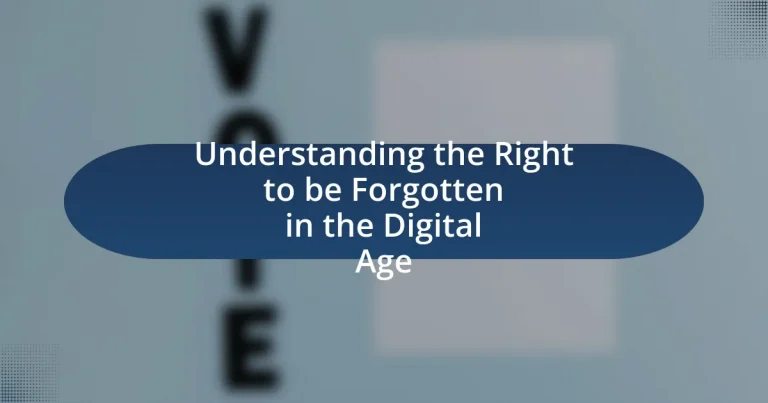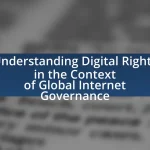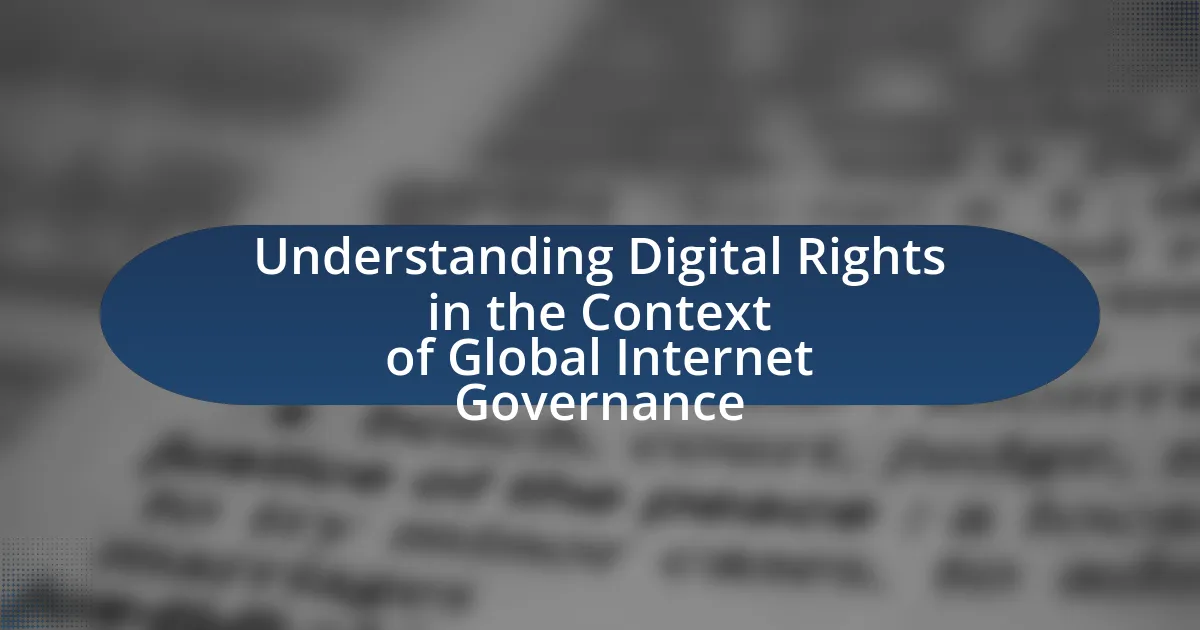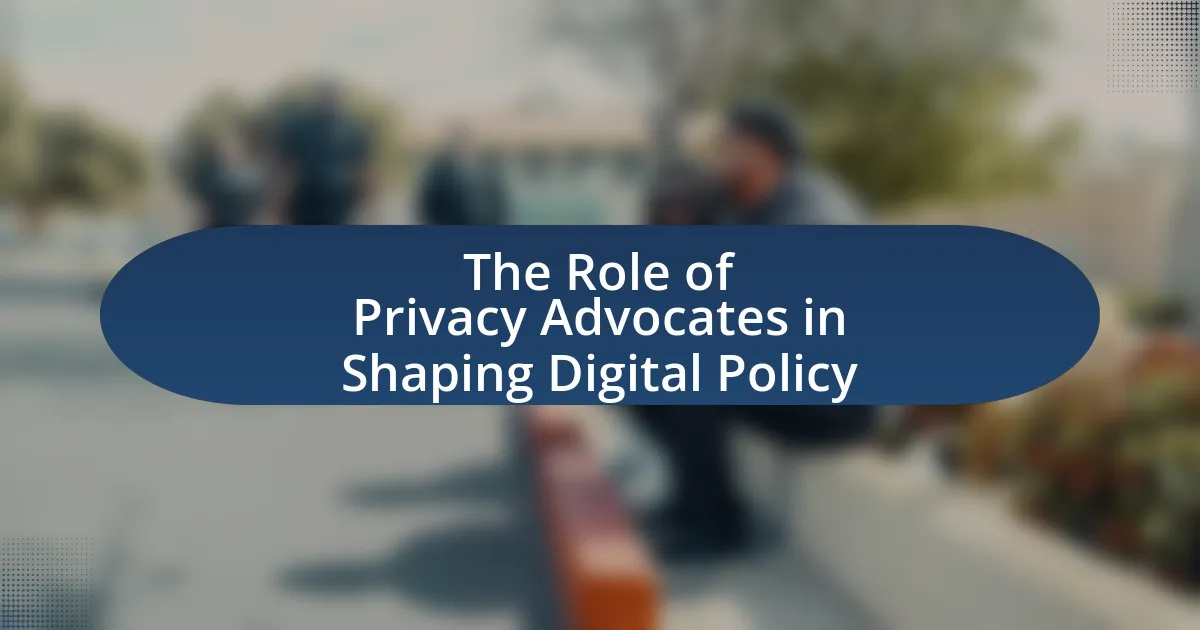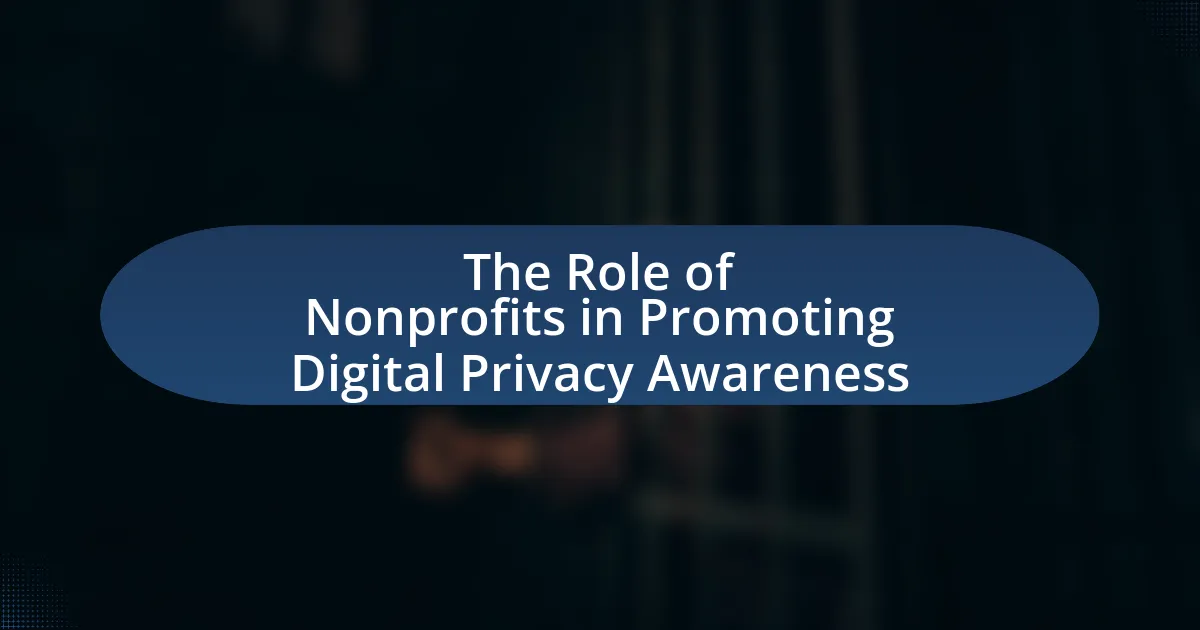The Right to be Forgotten is a legal concept that enables individuals to request the removal of personal information from search engines and online platforms under specific conditions, established by the European Court of Justice in 2014. This article explores the origins of this right, its supporting legal frameworks such as the General Data Protection Regulation (GDPR), and its evolution in response to technological and societal changes. It examines the implications for personal privacy, freedom of expression, and the challenges in enforcing this right, including varying interpretations across jurisdictions. Additionally, the article discusses the responsibilities of businesses in complying with these requests and the potential risks of non-compliance, while also highlighting future trends and best practices for individuals seeking to exercise their rights in the digital landscape.

What is the Right to be Forgotten?
The Right to be Forgotten is a legal concept that allows individuals to request the removal of personal information from search engines and online platforms under certain conditions. This right was established by the European Court of Justice in 2014, which ruled that individuals have the right to request the deletion of links to personal data that is inaccurate, irrelevant, or excessive in relation to the purposes for which it was processed. The ruling emphasizes the balance between privacy rights and the public’s right to access information, highlighting the importance of protecting individuals’ personal data in the digital age.
How did the Right to be Forgotten originate?
The Right to be Forgotten originated from a 2014 ruling by the Court of Justice of the European Union (CJEU), which established that individuals have the right to request the removal of personal information from search engine results under certain conditions. This landmark decision arose from a case involving a Spanish citizen, Mario Costeja González, who sought the removal of links to outdated information about his financial troubles. The court ruled that search engines must balance the public’s right to access information with individuals’ rights to privacy, thereby laying the foundation for this legal concept in the European Union.
What legal frameworks support the Right to be Forgotten?
The legal frameworks that support the Right to be Forgotten primarily include the General Data Protection Regulation (GDPR) in the European Union and various national laws that align with its principles. The GDPR, enacted in May 2018, explicitly grants individuals the right to request the deletion of personal data under certain conditions, such as when the data is no longer necessary for the purposes for which it was collected or when the individual withdraws consent. Additionally, the Court of Justice of the European Union (CJEU) ruling in the Google Spain case in 2014 established a precedent for this right, affirming that search engines must consider requests for de-referencing links to personal information. These legal frameworks collectively provide a robust basis for individuals seeking to exercise their Right to be Forgotten in the digital landscape.
How has the concept evolved over time?
The concept of the Right to be Forgotten has evolved significantly since its inception, primarily influenced by legal, technological, and societal changes. Initially recognized in European Union law through the 2014 Court of Justice of the European Union ruling, this right allowed individuals to request the removal of personal data from search engine results under certain conditions. Over time, the application of this right has expanded, with various countries considering similar legislation, reflecting a growing recognition of privacy in the digital age. For instance, the General Data Protection Regulation (GDPR), enacted in 2018, formalized the Right to be Forgotten across EU member states, establishing clearer guidelines for its implementation. This evolution demonstrates an increasing emphasis on individual privacy rights in response to the pervasive nature of digital information and the public’s demand for control over personal data.
Why is the Right to be Forgotten important in the digital age?
The Right to be Forgotten is important in the digital age because it empowers individuals to control their personal information online. This right allows people to request the removal of outdated or irrelevant data from search engines and websites, thereby protecting their privacy and reputation. For instance, a study by the European Data Protection Supervisor in 2018 highlighted that 60% of individuals felt that their online presence did not reflect their current identity, underscoring the necessity for such a right. By enabling individuals to erase harmful or inaccurate information, the Right to be Forgotten fosters a safer digital environment and promotes personal dignity in an era where information is easily accessible and often permanent.
What implications does it have for personal privacy?
The right to be forgotten significantly impacts personal privacy by allowing individuals to request the removal of their personal data from online platforms. This legal framework empowers users to control their digital footprint, thereby enhancing their privacy rights. For instance, the European Union’s General Data Protection Regulation (GDPR) grants individuals the ability to erase data that is no longer necessary for the purposes for which it was collected, reinforcing the notion that personal information should be managed with consent and respect for privacy. This regulation has led to increased accountability for organizations handling personal data, as they must comply with requests for data deletion, ultimately fostering a culture of privacy protection in the digital landscape.
How does it affect freedom of expression?
The Right to be Forgotten can significantly limit freedom of expression by allowing individuals to request the removal of personal information from search engines and online platforms. This legal framework can lead to the suppression of information that may be relevant to public discourse, as it prioritizes individual privacy over the public’s right to access information. For instance, in the European Union, the General Data Protection Regulation (GDPR) empowers individuals to request the deletion of data, which has resulted in numerous cases where search engines have removed links to articles or information that could be deemed damaging to an individual’s reputation. This balance between privacy and freedom of expression continues to be a contentious issue, as it raises questions about censorship and the public’s right to know.
What are the key principles of the Right to be Forgotten?
The key principles of the Right to be Forgotten include the individual’s right to request the removal of personal data from search engines and online platforms, particularly when that data is outdated, irrelevant, or harmful. This principle is rooted in the protection of personal privacy and dignity, allowing individuals to control their digital footprint. The European Court of Justice established this right in 2014, emphasizing that search engines must balance the individual’s rights against the public’s interest in accessing information. Additionally, the principle applies to data that is no longer necessary for the purposes for which it was collected, reinforcing the importance of data minimization in privacy regulations.
What criteria must be met for a request to be valid?
A request to be valid must meet specific criteria, including the identification of the individual making the request, the clear specification of the data to be removed, and the justification for the removal based on legal grounds such as irrelevance, excessive data, or outdated information. These criteria ensure that the request aligns with data protection regulations, such as the General Data Protection Regulation (GDPR), which mandates that individuals have the right to request the deletion of personal data under certain conditions. Valid requests must also be submitted to the appropriate data controller, who is responsible for processing the request in accordance with established legal frameworks.
How do different jurisdictions interpret these principles?
Different jurisdictions interpret the principles of the Right to be Forgotten in varied ways, reflecting their legal frameworks and cultural values. For instance, the European Union, through the General Data Protection Regulation (GDPR), emphasizes individual privacy rights, allowing individuals to request the removal of personal data under specific conditions. In contrast, the United States prioritizes freedom of speech, leading to a more limited application of similar principles, where the Right to be Forgotten is not formally recognized in federal law. Additionally, countries like Canada and Australia are exploring their own frameworks, balancing privacy rights with public interest considerations. These interpretations are shaped by legal precedents, societal norms, and the ongoing debate between privacy and freedom of expression.
How does the Right to be Forgotten interact with other rights?
The Right to be Forgotten interacts with other rights, particularly the right to freedom of expression and the right to privacy. This right allows individuals to request the removal of personal information from search engines and online platforms, balancing the need for personal privacy against the public’s interest in accessing information. For instance, the European Court of Justice ruling in 2014 established that individuals could request the delisting of links to information that is outdated or irrelevant, thereby affirming the right to privacy while also recognizing that such requests must be weighed against the public’s right to know. This interaction highlights the ongoing tension between protecting individual privacy and maintaining freedom of expression in the digital landscape.
What challenges arise in enforcing the Right to be Forgotten?
Enforcing the Right to be Forgotten presents several challenges, primarily related to balancing privacy rights with freedom of expression. One significant challenge is the ambiguity in defining what constitutes “harmful” information, leading to inconsistent application across jurisdictions. For instance, the European Court of Justice ruling in 2014 established the right, but its implementation varies among EU member states, complicating enforcement. Additionally, search engines and platforms often face difficulties in determining the legitimacy of requests, as they must evaluate the public interest against individual privacy rights. This complexity is further exacerbated by the global nature of the internet, where data may be stored and accessed across borders, creating legal conflicts.
What are the common obstacles faced by individuals?
Common obstacles faced by individuals include lack of awareness, legal complexities, and technological challenges. Lack of awareness about the Right to be Forgotten can prevent individuals from exercising their rights effectively, as many do not know they can request the removal of personal data. Legal complexities arise from varying regulations across jurisdictions, making it difficult for individuals to navigate the process. Additionally, technological challenges, such as the persistence of data on the internet and the difficulty in tracking down all instances of personal information, hinder individuals’ ability to fully control their digital footprint.
How do technology companies respond to these requests?
Technology companies typically respond to requests for the right to be forgotten by evaluating the legitimacy of the request against legal and regulatory frameworks. For instance, under the General Data Protection Regulation (GDPR) in Europe, companies must assess whether the request meets criteria such as the relevance of the data, the necessity for processing, and the individual’s rights. Companies like Google and Facebook have established processes for users to submit these requests, often requiring users to provide identification and justification for the removal. In 2020, Google reported receiving over 1.5 million removal requests, demonstrating the scale of such inquiries and the company’s commitment to compliance with privacy laws.

What are the implications of the Right to be Forgotten for businesses?
The Right to be Forgotten has significant implications for businesses, primarily affecting data management and compliance practices. Businesses must implement robust data governance frameworks to ensure they can effectively respond to requests for data deletion, which may require changes in their data storage and processing systems. For instance, companies operating in the European Union must comply with the General Data Protection Regulation (GDPR), which mandates that individuals can request the removal of personal data under certain conditions. Failure to comply can result in substantial fines, with penalties reaching up to 4% of annual global turnover or €20 million, whichever is higher. Additionally, businesses may face reputational risks if they are perceived as not respecting individuals’ privacy rights, potentially leading to loss of customer trust and loyalty.
How can businesses comply with the Right to be Forgotten?
Businesses can comply with the Right to be Forgotten by implementing processes that allow individuals to request the deletion of their personal data. This involves establishing a clear procedure for users to submit deletion requests, verifying the identity of the requester, and ensuring that data is removed from all systems, including backups, within a reasonable timeframe. Compliance is supported by regulations such as the General Data Protection Regulation (GDPR), which mandates that individuals have the right to request erasure of their data under specific circumstances, such as when the data is no longer necessary for the purposes for which it was collected.
What processes should be in place for handling requests?
To effectively handle requests related to the Right to be Forgotten, organizations should implement a structured process that includes clear guidelines for submission, assessment, and response. This process should begin with a user-friendly request submission form that allows individuals to clearly articulate their reasons for requesting data removal. Following submission, a designated team must assess the validity of each request based on established criteria, such as the relevance of the data and the individual’s rights under applicable laws, like the General Data Protection Regulation (GDPR).
Once the assessment is complete, the organization should communicate the decision to the requester, providing a rationale for approval or denial. Additionally, a record-keeping system must be in place to document all requests and outcomes, ensuring compliance and facilitating audits. This structured approach not only ensures transparency but also aligns with legal obligations, as demonstrated by GDPR Article 17, which outlines the right to erasure and the conditions under which it applies.
How can businesses balance compliance with operational needs?
Businesses can balance compliance with operational needs by integrating compliance frameworks into their operational processes. This approach ensures that compliance requirements, such as data protection regulations, are embedded within daily operations rather than treated as separate tasks. For instance, implementing automated compliance monitoring tools can streamline adherence to regulations while maintaining efficiency in operations. According to a study by the International Association of Privacy Professionals, organizations that adopt a proactive compliance strategy experience a 30% reduction in compliance-related costs, demonstrating that aligning compliance with operational workflows can enhance both regulatory adherence and operational efficiency.
What are the potential risks for businesses failing to comply?
Businesses failing to comply with the Right to be Forgotten face significant risks, including legal penalties, financial losses, and reputational damage. Non-compliance can lead to fines imposed by regulatory bodies; for instance, the General Data Protection Regulation (GDPR) allows for fines up to 4% of annual global turnover or €20 million, whichever is higher. Additionally, businesses may experience loss of customer trust, as consumers increasingly prioritize data privacy, leading to decreased customer loyalty and potential revenue decline. Furthermore, negative publicity from compliance failures can harm a company’s brand image, making it difficult to attract new customers and retain existing ones.
What legal consequences can arise from non-compliance?
Non-compliance with the Right to be Forgotten can lead to significant legal consequences, including fines, sanctions, and potential lawsuits. For instance, under the General Data Protection Regulation (GDPR), organizations that fail to comply with data removal requests can face fines of up to 4% of their annual global turnover or €20 million, whichever is higher. Additionally, individuals may pursue legal action for damages resulting from the unauthorized retention of their personal data, further complicating the legal landscape for non-compliant entities.
How can reputational damage impact a business?
Reputational damage can significantly impact a business by leading to decreased customer trust and loyalty. When a company’s reputation is tarnished, customers may choose to take their business elsewhere, resulting in a direct loss of revenue. For example, a study by the Harvard Business Review found that a 10% decline in reputation can lead to a 5% decrease in sales. Additionally, reputational damage can increase operational costs, as businesses may need to invest in public relations efforts to repair their image. This can divert resources away from core business activities, further affecting profitability.

What future trends can we expect regarding the Right to be Forgotten?
Future trends regarding the Right to be Forgotten will likely include increased legal recognition and enforcement across more jurisdictions, as countries continue to grapple with data privacy issues. The European Union’s General Data Protection Regulation (GDPR) has set a precedent, prompting other regions, such as California with its Consumer Privacy Act, to consider similar frameworks. Additionally, advancements in technology will facilitate more efficient processes for individuals to request data removal, as artificial intelligence and machine learning can streamline the identification of relevant data. Furthermore, public awareness and advocacy for digital rights are expected to grow, leading to more robust demands for transparency and accountability from tech companies regarding data handling practices.
How might technology influence the Right to be Forgotten?
Technology significantly influences the Right to be Forgotten by enabling the collection, storage, and dissemination of personal data, which complicates individuals’ ability to erase their digital footprints. The proliferation of data-driven technologies, such as artificial intelligence and machine learning, allows for the aggregation of vast amounts of personal information, making it challenging to identify and remove specific data points. For instance, search engines and social media platforms utilize algorithms that prioritize content visibility, often retaining information even after requests for removal are made. This dynamic is evidenced by the European Union’s General Data Protection Regulation (GDPR), which mandates that individuals can request the deletion of personal data, yet compliance varies based on technological capabilities and platform policies. Thus, while technology can facilitate the enforcement of the Right to be Forgotten, it also poses significant barriers that can hinder its effectiveness.
What role do artificial intelligence and data analytics play?
Artificial intelligence and data analytics play a crucial role in enhancing the effectiveness of the Right to be Forgotten by enabling the identification and removal of personal data from digital platforms. AI algorithms can analyze vast amounts of data to detect sensitive information that individuals wish to erase, while data analytics provides insights into data storage practices and user behavior. For instance, a study by the European Union Agency for Fundamental Rights highlights that AI can automate the process of data removal, making it more efficient and less prone to human error. This synergy between AI and data analytics not only streamlines compliance with privacy regulations but also empowers individuals to reclaim control over their personal information in the digital landscape.
How could emerging technologies change user expectations?
Emerging technologies could significantly change user expectations by enhancing personalization, privacy, and accessibility. For instance, advancements in artificial intelligence enable tailored user experiences, leading individuals to expect more relevant content and services. Additionally, technologies like blockchain can improve data security and transparency, raising user demands for control over personal information. According to a 2021 survey by PwC, 86% of consumers are concerned about data privacy, indicating a growing expectation for companies to prioritize user rights, including the right to be forgotten. This shift in expectations reflects a broader trend towards demanding greater accountability and ethical practices from digital service providers.
What best practices should individuals follow when exercising their Right to be Forgotten?
Individuals should follow a structured approach when exercising their Right to be Forgotten, which includes identifying specific data to be removed, verifying the legal basis for the request, and submitting a clear and concise request to the relevant data controller. This process ensures that individuals effectively communicate their needs and comply with legal requirements. For instance, under the General Data Protection Regulation (GDPR), individuals can request the deletion of personal data when it is no longer necessary for the purposes for which it was collected, or if they withdraw consent on which the processing is based. By understanding these criteria and providing necessary documentation, individuals can enhance the likelihood of their requests being granted.
How can individuals effectively submit a request?
Individuals can effectively submit a request by clearly identifying the specific information they want removed and providing relevant details to support their claim. This includes including personal identification information, links to the content in question, and a concise explanation of why the removal is justified under the Right to be Forgotten principles established by the European Union’s General Data Protection Regulation (GDPR). The GDPR allows individuals to request the deletion of personal data when it is no longer necessary for the purposes for which it was collected, or when they withdraw consent.
What resources are available for individuals seeking assistance?
Individuals seeking assistance regarding the Right to be Forgotten can access various resources, including legal aid organizations, online privacy advocacy groups, and governmental regulatory bodies. Legal aid organizations, such as the American Civil Liberties Union (ACLU), provide guidance on privacy rights and legal recourse. Online privacy advocacy groups, like the Electronic Frontier Foundation (EFF), offer resources and information on digital privacy issues. Additionally, governmental bodies, such as the European Data Protection Board (EDPB), provide official guidelines and support for individuals seeking to exercise their rights under data protection laws. These resources collectively empower individuals to understand and navigate their rights in the digital landscape.
